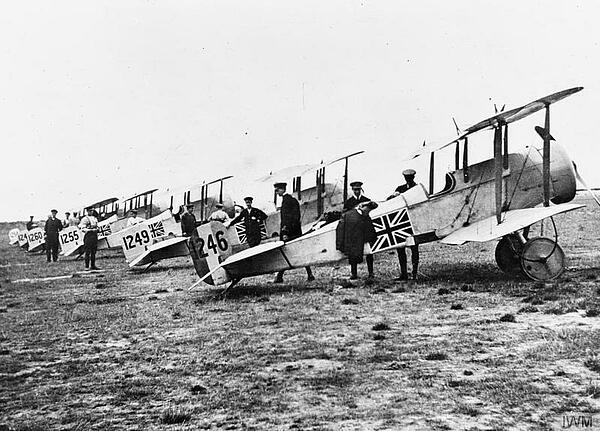Royal Naval Air Service
The Royal Naval Air Service (RNAS) was the flying branch of the Royal Navy. As World War One drew to a close, the RNAS was merged with the Royal Flying Corps to form the Royal Air Force.
The first time the idea of providing the Royal Navy with an aerial service was in 1908, when the idea emerged that the navy should have an airship. This idea was supported by First Sea Lord Sir John Fisher and the ‘Mayfly’ was built. However, it never flew and broke in half in September 1911, giving ammunition to sceptics of the idea.
In 1910, there were already four Royal Navy officers training to fly aircraft, but this was completed outside of formal training at the Royal Aero Club in Kent. Club members were acting as instructors rather than any official navy instructors. It was believed that the Admiralty had little faith in the idea, having stipulated that those trained be unmarried - anyone who engaged in aerial training pre-war were subjecting themselves to an activity with a very high fatality rate.
However, the idea that planes could be used to provide the navy with another layer of protection and offensive capability did begin to take hold. Seaplanes in particularly offered the navy advantage in the days before radar was introduced, providing fleets with a means of scouting for enemy ships and submarines.

In 1912, the Air Department at the Admiralty was created and commanded by Captain Murray Sueter, who was responsible for “all matters” connected to the Naval Air Service. A formal Naval Air Service seaplane base was established on the Isle of Grain, Kent, and in 1913 aircraft from the NAS formally took part in naval manoeuvres for he first time with ships from the Royal Navy.
The Naval Air Service officially became the Royal Naval. However, it became independent of the RFC on 1st August 1915 when it was put under control of the Royal Navy. By the time World War One had began, the RNAS had 93 aircraft, size airships and 720 staff.
During the war, the airships were based around the British coast to provide early warning of any approaching enemy ships and submarines. RNAS planes also patrolled the coastline and protected London from bombers and Zeppelins. However, it was not uncommon for the RNAS to initiate attacks on German coastal positions in Belgium and it also had two squadrons that were fighting on the Western Front, aiding the infantrymen.
RNAS rivalry with RFC became intense, exacerbated by the fact that only RFC pilots - such as Albert Ball and James McCudden - became known as flying aces rather than RNAS pilots. However, the RNAS still took part in their fair share of daring and dangerous missions. On Christmas Day 1914, for example, the RNAS attacked German Zeppelin bases at Cuxhaven and Wilhelmshaven. An RNAS pilot - Flight Commander C Edmonds - also attacked a Turkish ship with a torpedo attached to his aircraft during the Gallipoli campaign, sinking the ship by flying just 15 feet above the sea.
The growth of the RNAS was also enormous, highlighting the real need for an aerial service in the Royal Navy. By the time the RNAS merged with the RFC, its had grown its staff from 720 to 55,000, grown its aircraft from 93 to 3,000 and grown its airships from six to 103.
MLA Citation/Reference
"Royal Naval Air Service". HistoryLearning.com. 2026. Web.
